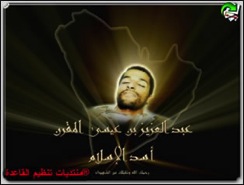
It is believed that Muslim martyrs will be highly rewarded in the afterlife for their sacrifice and that they hold a special position in heavenly paradise. It is therefore not surprising that martyrdom is a central theme in jihadi visual propaganda. In this image, we see a common technique for depicting martyrs in jihadi visual propaganda, which combines a photograph of a martyr with a representation of the country in which he was killed or from which he originated. The purpose is to draw attention to the jihadi activities taking place within that country. Thus, this method both nationalizes the martyrdom and internationalizes what began as a local conflict.
In this specific image, the figure, ‘Abd al-‘Aziz al-Muqrin, is shown against a white background of light rays evoking notions of death (in the state of purity), shrouds, grief, mourning and the attainment of martyrdom. Depicting the Saudi state alone, without bordering countries or bodies of water, evokes the national context and scope of the specific jihad underway in that country. At the same time, because the figure of ‘Abd al-‘Aziz has been superimposed on the Saudi map, there is clearly an attempt to associate the source of the image (the forum) with al-Qa’ida and the global jihadi movement in general.
‘Abd al-‘Aziz al-Muqrin was the head of al-Qa’ida in Saudi Arabia and the mastermind behind the suicide bombing of a residential housing compound in Riyadh on 8 November 2003, in which seventeen people were killed. The last operation commanded by ‘Abd al-‘Aziz was probably the 18 June 2004 beheading of the American hostage Paul Johnson. It was reported that a few hours after this operation, when ‘Abd al-‘Aziz was moving the American engineer’s body, he was killed after being surrounded by local Saudi forces. The caption at the bottom of the image reads: “‘Abd al-‘Aziz bin ‘Isa al-Muqrin asad al-islam; rahimak Allah wa-taqabbalak ma‘a al-shuhada’” (“‘Abd al-‘Aziz bin ‘Isa al-Muqrin is the lion of Islam; may God have mercy on you and accept you amongst the martyrs”).
 Skip to content
Skip to content
